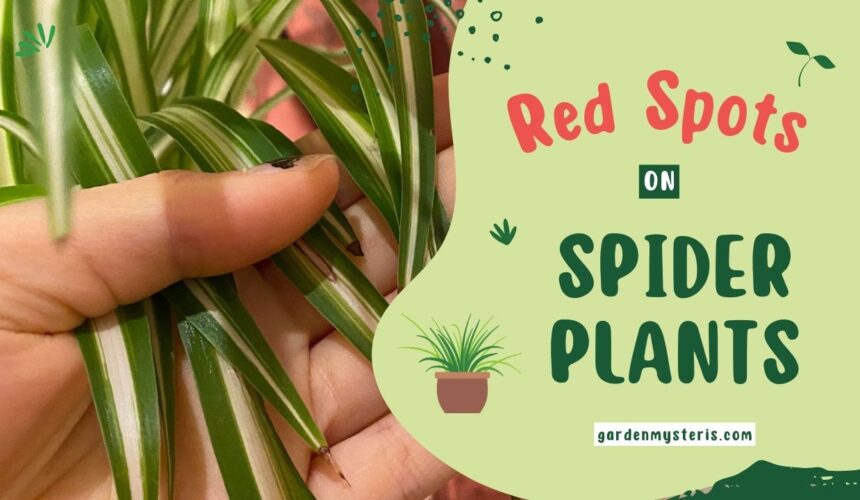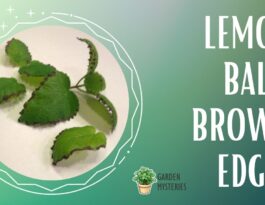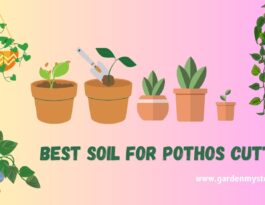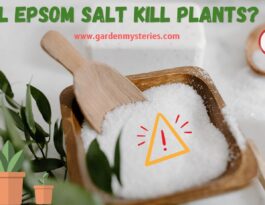Are you wondering about why there are so many red spots on spider plant? Red spots can occur due to factors like sunburn from excessive sunlight, pest infestations, diseases, nutrient deficiencies, or improper watering. Here, we will comprehensively discuss spots on spider plants along with related facts.
Is Red Spots on Spider Plant Normal?
A few red spots on a spider plant’s leaves can be considered normal and might not necessarily indicate a problem. So don’t panic right away saying what’s wrong with my spider plant.
In some cases, these spots could be caused by natural variations in pigmentation or minor stressors that don’t seriously affect the plant’s health. However, if you notice an excessive number of red spots, or if the spots are accompanied by other symptoms such as wilting, yellowing, or browning of the leaves, it could indicate an underlying issue that requires attention.
If you’re uncertain about whether the red spots on your spider plant are normal or indicative of a problem, consider observing the plant over a period of time.
If the spots remain minimal and the plant continues to grow and thrive, they may be within the range of normal variation. However, if the spots increase in number, size, or severity, it’s advisable to investigate further and take appropriate measures to ensure the plant’s well-being.
Reasons Why My Spider Plants Have So Many Red Spots?
Here are some reasons why your spider plants might be displaying numerous red spots on their leaves, along with generic symptoms that could indicate the presence of these issues:
- Pest Infestation: Common pests like spider mites or mealybugs can cause spider plant red edges or spots as they feed on the plant’s tissues.
- Generic Symptoms: Tiny webs, visible insects, white cottony clusters, and distorted leaves.
- Diseases: Fungal or bacterial infections can lead to red spots and discoloration on the leaves.
- Generic Symptoms: Spots may appear water-soaked, turn brown or black, and may spread rapidly. Leaves might also show signs of wilting.
- Sunburn: Exposing the plant to intense, direct sunlight can cause red or brown spots due to sunburn.
- Generic Symptoms: Irregularly shaped spots that are more prominent on areas directly exposed to the sun.
- Nutrient Deficiencies: Lack of essential nutrients like magnesium or potassium can manifest as red spots.
- Generic Symptoms: Yellowing of leaves along with red or brown spots, stunted growth, and overall poor plant health.
- Overwatering or Underwatering: Both overwatering and underwatering can stress the plant and lead to leaf issues, including red spots.
- Generic Symptoms: Wilting, drooping leaves, yellowing, and root rot (for overwatering) or dry, crispy leaves (for underwatering).
- Temperature Stress: Exposure to extreme temperatures, especially cold drafts, can cause red spots to develop.
- Generic Symptoms: Leaves might become discolored, curl, or develop spots, particularly if the plant is placed near drafty windows or air conditioning.
- Root Bound: When the plant’s roots outgrow the pot, it can affect nutrient absorption and lead to red spots.
- Generic Symptoms: Slowed growth, crowded roots in the pot, and signs of nutrient deficiencies.
- Chemical Exposure: Exposure to chemicals such as household cleaners or pesticides can cause red spots.
- Generic Symptoms: Irregularly shaped spots that may vary in color, and the presence of other signs of chemical damage.
- Stress or Shock: Sudden changes in environment, such as moving the plant abruptly, can lead to red spots as the plant reacts to stress.
- Generic Symptoms: Spots may appear along with wilting, drooping, or other signs of shock.
- Genetic Factors: Some propagate spider plant varieties naturally have red spots or margins on their leaves as a part of their genetic makeup.
- Generic Symptoms: Consistent presence of red spots on certain leaves, possibly following the plant’s natural pattern.
It’s important to identify the specific cause of red spots on your propagate spider plants to provide appropriate treatment. Monitoring your plant’s overall health, practicing good care habits, and taking prompt action can help ensure your benefits spider plants remain vibrant and problem-free.
Did you check out another of my last articles? It was about problems and solutions related to orchid stem turning pink.
Solutions At A Glance: Red Spots on Spider Plant
Here’s a table for addressing the issues and corresponding solution about red spots on spider plants:
| Issue | Solution |
| Too much sunlight | Place in filtered or indirect sunlight. |
| Pests | Treat with insecticidal soap or neem oil. |
| Diseases | Trim affected leaves and apply fungicide if needed. |
| Nutrient deficiencies | Fertilize with balanced, diluted fertilizer. |
| Watering issues | Adjust watering to maintain consistent moisture. |
| Temperature stress | Avoid extreme temperatures and cold drafts. |
| Root bound | Repot in a larger container with fresh soil. |
| Chemical exposure | Rinse leaves thoroughly and avoid further exposure. |
| Genetic factors | Monitor plant’s overall health and appearance. |
| Stress or shock | Gradually acclimate plant to new conditions. |

How to Treat Spider Plants with Red Spots?
Treating spider plants with red spots involves identifying and addressing the underlying causes. Here’s a step-by-step guide to help you effectively treat your spider plants:
Step 1: Inspect the Spider Plant
Carefully examine the affected spider plant to determine the extent of the red spots and any accompanying symptoms. Look for signs of pests, diseases, or other stress factors.
Step 2: Identify the Cause
Determine the specific reason for the red spots, such as pests, diseases, nutrient deficiencies, or environmental stressors. This step is crucial for implementing the appropriate treatment.
Step 3: Adjust Watering
Ensure you are watering your spider plant correctly. Allow the top inch of soil to dry out before watering again. Overwatering can lead to root issues, while underwatering can stress the plant.
Step 4: Inspect for Pests
Check the undersides of leaves, stems, and the soil for signs of pests like spider mites, mealybugs, or aphids. If pests are present, isolate the plant to prevent infestation of other plants.
Step 5: Pest Treatment
For minor infestations, wipe leaves with a damp cloth or use a gentle spray of water to dislodge pests. For more severe cases, treat with insecticidal soap, neem oil, or another suitable insecticide according to package instructions.
Step 6: Disease Management
If you suspect a disease, remove and dispose of severely affected leaves. Improve air circulation around the plant by pruning crowded foliage. Use a fungicide if the issue persists, following product guidelines.
Step 7: Nutrient Correction
If nutrient deficiencies are suspected, fertilize the plant with a balanced, water-soluble fertilizer diluted to half strength. Choose a fertilizer with equal or higher amounts of nitrogen (N), phosphorus (P), and potassium (K).
Step 8: Environmental Adjustments
Place the plant in an appropriate location with proper lighting. Avoid direct sunlight, extreme temperatures, or cold drafts that could stress the plant.
Step 9: Repotting
If the plant is root-bound, repot it into a slightly larger container with fresh, well-draining potting mix. This can help improve root health and nutrient absorption.
Step 10: Isolate the Spider Plant
If you’re unsure of the cause and treatment, isolate the affected plant to prevent potential spread to other plants. Observe the isolated plant closely to monitor its recovery.
Step 11: Consistent Care
Provide ongoing care, including proper watering, adequate lighting, regular cleaning of leaves, and appropriate fertilization to support the plant’s recovery and overall health.
Step 12: Monitor and Patience
Give the plant time to recover. Monitor its progress and make adjustments as needed based on its response to the treatments.
Remember that different causes require different approaches, so accurately identifying the issue is key to successful treatment. If the red spots persist or worsen despite your efforts, consider seeking advice from a local nursery or a plant care expert.

Why Is My Spider Plant Pale and Limp
A pale and limp spider plant is likely experiencing stress due to improper care. Inadequate light, overwatering, or poor drainage can cause this issue. Insufficient light results in reduced photosynthesis, leading to pale leaves and weak growth. Overwatering suffocates roots, causing them to rot and preventing water uptake, resulting in limpness.
To remedy the situation, place the plant in bright, indirect light, allowing the soil to slightly dry between waterings. Ensure proper drainage to prevent root rot. Trimming any yellow or damaged leaves encourages new growth.
FAQs
Can overwatering cause red spots on spider plants?
Yes, overwatering can lead to root rot, limiting nutrient uptake and causing red spots. Ensure the plant’s pot has proper drainage and allow the soil to dry moderately between waterings.
Are red spots a sign of disease in spider plants?
Red spots can indicate diseases, such as fungal or bacterial infections. If spots spread, darken, or affect plant health, consider treating with appropriate fungicides or bactericides and enhancing air circulation.
Can spider mites cause red spots on spider plants?
Yes, spider mites are common pests that can cause red spots as they feed on leaves. Inspect the plant for tiny webs, and discolored spots, and treat with neem oil or insecticidal soap to control infestations.
We have also covered reasons and solutions for brown orchid roots, you may like this article too. So, check it out in your leisure time.





